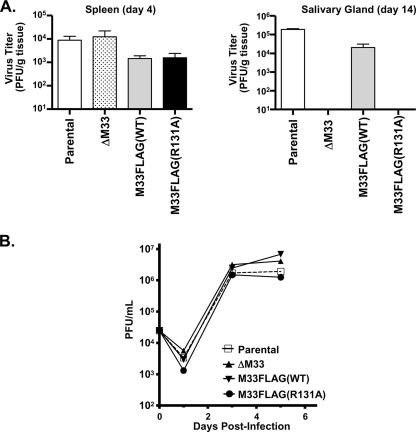FIG. 1.
M33FLAG(R131A) recombinant virus fails to persist in the salivary glands. (A) Female BALB/c Mice were infected intraperitoneally with 5 × 105 PFU of K181 BAC-derived parental, ΔM33, M33FLAG(WT), or M33FLAG(R131A) viruses. Groups of three mice were sacrificed on day 4 or day 14 postinfection, and their spleens and salivary glands were harvested. Tissues were homogenized, and virus titers were assessed by plaque assay on NIH 3T3 cells. Virus titers from spleens isolated at 4 days postinfection (left panel) or from salivary glands isolated at 14 days postinfection (right panel) are depicted graphically. (B) The ability of each of the BAC-derived viruses to replicate in salivary epithelial cells was also assessed in the salivary gland cell line SGC-1. Multistep growth curves were performed by infecting subconfluent SGC-1 cells at a multiplicity of infection of 0.1. Samples of tissue culture supernatant were taken at days 1, 3, and 5 postinfection, and virus titers were determined by plaque assay. The data represent the means of three independent experiments.

